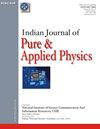(Ti, Cr)共掺杂SnO2纳米颗粒结构和介电性能研究
IF 1.1
4区 物理与天体物理
Q4 PHYSICS, MULTIDISCIPLINARY
引用次数: 0
摘要
本文研究了(Ti, Cr)共掺杂对SnO2纳米粒子结构、光学和介电性能的影响。采用传统的固相反应途径制备了未掺杂、Ti掺杂和(Ti, Cr)共掺杂的SnO2纳米颗粒。结构分析表明,所制备的样品均为多晶性质,为单相四方金红石型结构。晶粒尺寸随着掺杂的增加而增加。扫描电镜显示纳米颗粒呈球形,分布均匀。与未掺杂的SnO2相比,掺杂样品的光学带隙能量有很小的变化。据报道,在介电功能、电容、介电损耗因子和交流电导率等参数上发生了重大变化。麦克斯韦-瓦格纳模型适用于描述介电常数和介电损耗随频率的变化规律。Ti和Cr共掺杂的SnO2纳米粒子比Ti掺杂和未掺杂的SnO2纳米粒子具有更低的介电损耗。所有制备样品的交流电导率随频率和掺杂的增加而增加。掺钛的SnO2纳米粒子表现出较高的交流电导率,这可以通过载流子的跳变来解释。本文章由计算机程序翻译,如有差异,请以英文原文为准。
Study on Structural and Dielectric Properties of (Ti, Cr) co-doped SnO2 Nanoparticles
The present study deals with the impact of (Ti, Cr) co-doping on the structural, optical, and dielectric properties of the SnO2 nanoparticles. The traditional solid-state reaction route is adopted to prepare undoped, Ti-doped and (Ti, Cr) co-doped SnO2 nanoparticles. The structural analysis revealed the polycrystalline nature with a single phase of tetragonal rutile type structure for all the prepared samples. The increment in the crystallite size is observed with doping. The Scanning electron microscopy showed that the nanoparticles are spherical and uniformly distributed. A small variation is noticed in the optical band gap energy of doped samples as compared to the undoped SnO2. The significant changes have been reported in parameters such as dielectric function, capacitance, dielectric loss factor, and AC conductivity. Maxwell-Wagner model is suitable to illustrate the decreasing behaviour of dielectric constant and dielectric loss with frequency. Ti and Cr co-doped SnO2 nanoparticles revealed lower dielectric loss contrary to Ti-doped and undoped SnO2 nanoparticles. The ac conductivity of all the prepared samples increases with frequency and doping. Ti-doped SnO2 nanoparticles exhibited higher ac conductivity, which can be explained by the hopping of charge carriers.
求助全文
通过发布文献求助,成功后即可免费获取论文全文。
去求助
来源期刊
CiteScore
1.30
自引率
14.30%
发文量
42
审稿时长
7 months
期刊介绍:
Started in 1963, this journal publishes Original Research Contribution as full papers, notes and reviews on classical and quantum physics, relativity and gravitation; statistical physics and thermodynamics; specific instrumentation and techniques of general use in physics, elementary particles and fields, nuclear physics, atomic and molecular physics, fundamental area of phenomenology, optics, acoustics and fluid dynamics, plasmas and electric discharges, condensed matter-structural, mechanical and thermal properties, electronic, structure, electrical, magnetic and optical properties, cross-disciplinary physics and related areas of science and technology, geophysics, astrophysics and astronomy. It also includes latest findings in the subject under News Scan.

 求助内容:
求助内容: 应助结果提醒方式:
应助结果提醒方式:


